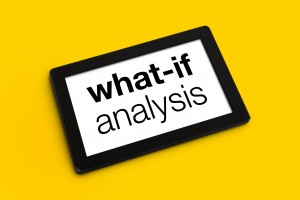24 Jul How-to for “What-if” Planning for Executives

Balanced Scorecards and Spreadsheets: The Right Starting Point?
A recent insight by Bain and Company discusses Balanced Scorecards as one kind of management tool. While balanced scorecards have been in use by organizations for years, one trend we see is organizations and executives using balanced scorecards to perform (or try to perform) what-if scenarios.
Bain and Company lists the following as what balanced scorecards do:
- Articulate the business’s vision and strategy
- Identify the performance categories that best link the business’s vision and strategy to its results (e.g., financial performance, operations, innovation, employee performance)
- Establish objectives that support the business’s vision and strategy
- Develop effective measures and meaningful standards, establishing both short-term milestones and long-term targets
- Ensure companywide acceptance of the measures
- Create appropriate budgeting, tracking, communication, and reward systems
- Collect and analyze performance data and compare actual results with desired performance
- Take action to close unfavorable gaps
Actually, Bain and Company does not number the steps, we did this to articulate what we view is a large gap between steps 6 and 7. Once we describe how to fill the gap between steps 6 and 7, the processes and tools we use can be leveraged in all the above steps.
Most balanced scorecards show what happened within the business and where the organization may need to take action. Hence, the gap – what actions shall the organization take? The Good news is that a balanced scorecard is very metric or KPI focused, therefore, cause and actions in a balanced scorecard scenario can be KPI-based. When we can focus improvement efforts on KPIs and provide concrete goals for KPIs, we now have goal attainment, scenario analysis, or What-if analysis.
[optin-monster-inline slug=”qloggraxd3payfghmxer”]
A challenge of goal attainment is that these what-if scenarios need to be performed by analysts using complicated spreadsheets. This can take hours or days or even weeks to model with a spreadsheet, or multiple spreadsheets, and then adjust the various parameters to understand the effect of those parameters on your goals. To help organizations start the thinking process on transforming from “what happened” (balanced scorecard) to “what do I do” (goal attainment) Sage Clarity prescribes a very different approach. First and foremost, the ability for executives in an organization to run their own scenarios is crucial.
Imagine the engagement from the employee base when executives are running goal attainment experiments from a meeting on their tablet or smartphone.
Fundamentally speaking, the concept of goal attainment is to adjust 1 or more KPIs to determine the affect on other KPIs. Lets take inventory as an example: with inventory, different members of an organization have different perspectives. Some members of the team view and manage inventory by days (days of inventory), some by volume and some by inventory cost – days, dollars or cases.
In summary, look to using more sophisticated tools to perform what-if scenarios vs. standard tools meant for balanced scorecards. Such tools can:
- Compress the decision making cycle when trying to make quick assessments
- Predict outcomes to understand whether goals or targets can be met
- Include and embed executives in the decision making process – from their smartphone or tablet!


